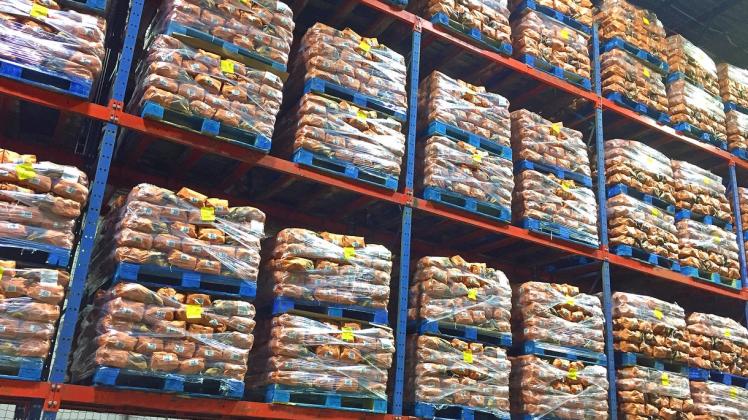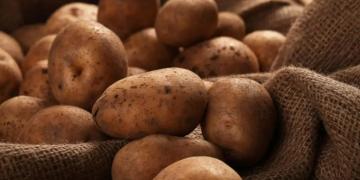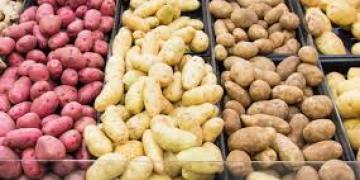Generalidades: Promoting potato as staple food can reduce the carbon–land–water impacts of crops in China
China has recently implemented a policy to promote potato as a national staple food and to close its large yield gaps with other countries.

Abstract
The carbon–land–water implications of this policy are examined here by compiling and analysing detailed city-level life-cycle inventories of China’s staple crops.
We find that in general potato, despite relatively low yields, has lower greenhouse gas emissions and water demand than other staple crops (maize, wheat and rice) on a per-calorie basis, but substantial regional variation exists for each crop. Integrating potato as a staple in China to meet increases in food demand and close the yield gap has the potential to reduce the total carbon–land–water impacts of staple crops by 17–25% by 2030.
However, an unsuccessful integration runs the risk of global burden-shifting if the policy, for example, reduced domestic rice production and led to increased rice imports. Potential synergies between food security and environmental sustainability in China can be created by the potato policy, but greater efforts are needed to promote potato across the entire food supply chain from production to consumption.
Data availability
All the data that support the life-cycle inventory and scenario analyses of this study are from public sources clearly referenced in the manuscript and most of the data are provided in the Supplementary Information. Source data are provided with this paper.
Code availability
The codes used for data processing, analysis and visualization during the current study are available from the corresponding author on reasonable request.
References
1.
Chen, X. P. et al. Producing more grain with lower environmental costs. Nature 514, 486–489 (2014).
ADS
CAS
PubMed
Article
PubMed Central
Google Scholar
2.
Ma, L. et al. Environmental assessment of management options for nutrient flows in the food chain in China. Environ. Sci. Technol. 47, 7260–7268 (2013).
ADS
CAS
PubMed
Article
PubMed Central
Google Scholar
3.
Fan, M. S. et al. Improving crop productivity and resource use efficiency to ensure food security and environmental quality in China. J. Exp. Bot. 63, 13–24 (2012).
CAS
PubMed
Article
PubMed Central
Google Scholar
4.
You, L. Z., Rosegrant, M. W., Wood, S. & Sun, D. S. Impact of growing season temperature on wheat productivity in China. Agric. For. Meteorol. 149, 1009–1014 (2009).
ADS
Article
Google Scholar
5.
Wang, H. L. et al. Phenological trends in winter wheat and spring cotton in response to climate changes in Northwest China. Agric. For. Meteorol. 148, 1242–1251 (2008).
ADS
Article
Google Scholar
6.
Tao, F. L., Zhang, Z., Zhang, S., Zhu, Z. & Shi, W. J. Response of crop yields to climate trends since 1980 in China. Clim. Res. 54, 233–247 (2012).
Article
Google Scholar
7.
Tao, F. L., Yokozawa, M., Liu, J. Y. & Zhang, Z. Climate-crop yield relationships at provincial scales in China and the impacts of recent climate trends. Clim. Res. 38, 83–94 (2008).
Article
Google Scholar
8.
Tao, F. L., Yokozawa, M., Xu, Y. L., Hayashi, Y. & Zhang, Z. Climate changes and trends in phenology and yields of field crops in China, 1981–2000. Agric. For. Meteorol. 138, 82–92 (2006).
ADS
Article
Google Scholar
9.
Chen, C., Wang, E. L., Yu, Q. & Zhang, Y. Q. Quantifying the effects of climate trends in the past 43 years (1961–2003) on crop growth and water demand in the North China Plain. Clim. Change 100, 559–578 (2010).
ADS
Article
Google Scholar
10.
Zhang, P., Zhang, J. J. & Chen, M. P. Economic impacts of climate change on agriculture: the importance of additional climatic variables other than temperature and precipitation. J. Environ. Econ. Manage. 83, 8–31 (2017).
Article
Google Scholar
11.
Lobell, D. B., Schlenker, W. & Costa-Roberts, J. Climate trends and global crop production since 1980. Science 333, 616–620 (2011).
ADS
CAS
PubMed
Article
PubMed Central
Google Scholar
12.
National Bureau of Statistics of China. China Statistical Yearbook 1981–2018 (China Statistics Press, 1982–2019).
13.
Frank, S. et al. Agricultural non-CO2 emission reduction potential in the context of the 1.5°C target. Nat. Clim. Chang. 9, 66–72 (2019).
ADS
CAS
Article
Google Scholar
14.
Smith, L. E. D. & Siciliano, G. A comprehensive review of constraints to improved management of fertilizers in China and mitigation of diffuse water pollution from agriculture. Agric. Ecosyst. Environ. 209, 15–25 (2015).
Article
Google Scholar
15.
Huang, J., Xu, C. C., Ridoutt, B. G., Wang, X. C. & Ren, P. A. Nitrogen and phosphorus losses and eutrophication potential associated with fertilizer application to cropland in China. J. Clean. Prod. 159, 171–179 (2017).
Article
Google Scholar
16.
Su, W. & Wang, J. Potato and food security in China. Am. J. Potato Res. 96, 100–101 (2019).
Article
Google Scholar
17.
Singh, J., Kaur, L. & Moughan, P. J. Importance of chemistry, technology and nutrition in potato processing. Food Chem. 133, 1091–1091 (2012).
CAS
Article
Google Scholar
18.
China Agricultural Yearbook Editorial Committee. China Agriculture Yearbook 1980–2017 (China Agriculture Press, 1981–2018).
19.
Gao, B. et al. Comprehensive environmental assessment of Potato as Staple Food policy in China. Int. J. Environ. Res. Public Health 16, 19 (2019).
Google Scholar
20.
Bleischwitz, R. et al. Resource nexus perspectives towards the United Nations Sustainable Development Goals. Nat. Sustain. 1, 737–743 (2018).
Article
Google Scholar
21.
Deng, H. M., Wang, C., Cai, W. J., Liu, Y. & Zhang, L. X. Managing the water–energy–food nexus in China by adjusting critical final demands and supply chains: an input–output analysis. Sci. Total Environ. 720, 11 (2020).
Article
CAS
Google Scholar
22.
Paustian, K. et al. Climate-smart soils. Nature 532, 49–57 (2016).
ADS
CAS
PubMed
Article
PubMed Central
Google Scholar
23.
Bennetzen, E. H., Smith, P. & Porter, J. R. Agricultural production and greenhouse gas emissions from world regions—the major trends over 40 years. Glob. Environ. Change 37, 43–55 (2016).
Article
Google Scholar
24.
Hu, H. Y. Distribution of China’s population: accompanying charts and density map. Acta Geogr. Sin. 2, 33–74 (1935).
Google Scholar
25.
FAOSTAT (Food and Agriculture Organization, 2020); http://faostat3.fao.org/faostat-gateway/go/to/home/E
26.
Guidelines of Ministry of Agriculture on Promoting the Development of Potato Industry (Plant Management Division Ministry of Agriculture. 2016).
27.
China’s Potato-as-Staple Food Policy Launched (People’s Political Consultative Conference, 2015); http://cppcc.people.com.cn/n/2015/0108/c34948-26348803.html
28.
Chen, M., Sun, J., Guo, Y. & Wang, X. A Brief History of the Potato: China’s Staple Food, 156–195 (China Agriculture Press, 2020).
29.
Fan, X., Zhang, W., Chen, W. W. & Chen, B. Land–water–energy nexus in agricultural management for greenhouse gas mitigation. Appl. Energy 265, 11 (2020).
Article
Google Scholar
30.
Carlson, K. M. et al. Greenhouse gas emissions intensity of global croplands. Nat. Clim. Chang. 7, 63–68 (2017).
ADS
CAS
Article
Google Scholar
31.
Liu, X., Li, S., He, P., Zhang, P. & Duan, Y. Yield and nutrient gap analysis for potato in northwest China. J. Agric. Sci. 156, 971–979 (2018).
CAS
Article
Google Scholar
32.
Yang, Y., Pelton, R. E. O., Kim, T. & Smith, T. M. Effects of spatial scale on life cycle inventory results. Environ. Sci. Technol. 54, 1293–1303 (2020).
ADS
CAS
PubMed
Article
PubMed Central
Google Scholar
33.
Miller, S. A., Landis, A. E. & Theis, T. L. Use of Monte Carlo analysis to characterize nitrogen fluxes in agroecosystems. Environ. Sci. Technol. 40, 2324–2332 (2006).
ADS
CAS
PubMed
Article
PubMed Central
Google Scholar
34.
Yang, Y., Bae, J., Kim, J. & Suh, S. Replacing gasoline with corn ethanol results in significant environmental problem-shifting. Environ. Sci. Technol. 46, 3671–3678 (2012).
ADS
CAS
PubMed
Article
PubMed Central
Google Scholar
35.
Yadav, O. P., Singh, D. V., Dhillon, B. S. & Mohapatra, T. India’s evergreen revolution in cereals. Curr. Sci. India 116, 1805–1808 (2019).
Article
Google Scholar
36.
Wang, Q. B., Parsons, R. & Zhang, G. X. China’s dairy markets: trends, disparities, and implications for trade. China Agr. Econ. Rev. 2, 356–371 (2010).
Article
Google Scholar
37.
Campbell, B. M. et al. Agriculture production as a major driver of the Earth system exceeding planetary boundaries. Ecol. Soc. 22, 11 (2017).
Article
Google Scholar
38.
Shafiee-Jood, M. & Cai, X. M. Reducing food loss and waste to enhance food security and environmental sustainability. Environ. Sci. Technol. 50, 8432–8443 (2016).
ADS
CAS
PubMed
Article
PubMed Central
Google Scholar
39.
Hasegawa, T., Havlik, P., Frank, S., Palazzo, A. & Valin, H. Tackling food consumption inequality to fight hunger without pressuring the environment. Nat. Sustain. 2, 826–833 (2019).
Article
Google Scholar
40.
Lu, Y. et al. Addressing China’s grand challenge of achieving food security while ensuring environmental sustainability. Sci. Adv. 1, e1400039 (2015).
ADS
PubMed
PubMed Central
Article
Google Scholar
41.
Kroll, C., Warchold, A. & Pradhan, P. Sustainable Development Goals (SDGs): are we successful in turning trade-offs into synergies? Palgrave Commun. 5, 11 (2019).
Article
Google Scholar
42.
Stewart, D. & McDougall, G. Potato: A Nutritious, Tasty but Often Maligned Staple Food (Food & Health Innovation Service, 2012).
43.
Tilman, D. & Clark, M. Global diets link environmental sustainability and human health. Nature 515, 518–522 (2014).
ADS
CAS
PubMed
Article
PubMed Central
Google Scholar
44.
Allen, R. G., Pereira, L. S., Raes, D. & Smith, M. Crop Evapotranspiration: Guidelines for Computing Crop Requirements. Irrigation and Drainage Paper No. 56 (Food and Agriculture Organization, 1998).
45.
Chiu, Y. W., Walseth, B. & Suh, S. Water embodied in bioethanol in the United States. Environ. Sci. Technol. 43, 2688–2692 (2009).
ADS
CAS
PubMed
Article
PubMed Central
Google Scholar
46.
Yang, Y. & Suh, S. Land cover change from cotton to corn in the USA relieves freshwater ecotoxicity impact but may aggravate other regional environmental impacts. Int. J. Life Cycle Assess. 20, 196–203 (2015).
CAS
Article
Google Scholar
47.
Gao, B. et al. Chinese cropping systems are a net source of greenhouse gases despite soil carbon sequestration. Glob. Chang. Biol. 24, 5590–5606 (2018).
PubMed
Article
PubMed Central
Google Scholar
48.
Tilman, D., Balzer, C., Hill, J. & Befort, B. L. Global food demand and the sustainable intensification of agriculture. Proc. Natl Acad. Sci. USA 108, 20260–20264 (2011).
ADS
CAS
PubMed
PubMed Central
Article
Google Scholar
49.
USDA National Nutrient Database for Standard Reference (United States Department of Agriculture, Agriculture Research Services & Nutrient Data Laboratory, 2016); https://ndb.nal.usda.gov/
50.
China Agriculture Outlook (2020–2029) (Institute of Agricultural Information and Chinese Academy of Agricultural Sciences, 2020).
51.
Wang, W., Bian, Y. & Liu, Y. China’s per capita GDP forecast and ranking change. Contemp. Finan. Stud. 9, 22–42 (2018).
CAS
Google Scholar
52.
World Population Prospects: The 2015 Revision (United Nations Department of Economic and Social Affairs, 2015).
53.
Deng, N. Y. et al. Closing yield gaps for rice self-sufficiency in China. Nat. Commun. 10, 1725 (2019).
ADS
PubMed
PubMed Central
Article
CAS
Google Scholar
54.
Hatfield, J. L. & Beres, B. L. Yield gaps in wheat: path to enhancing productivity. Front. Plant Sci. 10, 1603 (2019).
PubMed
PubMed Central
Article
Google Scholar
55.
Meng, Q. F. et al. Understanding production potentials and yield gaps in intensive maize production in China. Field Crop Res. 143, 91–97 (2013).
Article
Google Scholar
56.
National Planting Structure Adjustment Plan (2016–2020) (Ministry of Agriculture, 2016).
57.
China Agriculture Outlook (2019–2028) (Institute of Agricultural Information and Chinese Academy of Agricultural Sciences, 2019).
58.
Heffer, P. Assessment of Fertilizer Use by Crop at the Global Level (International Fertilizer Association, 2013).
59.
Data Bank: World Development Indicators (World Bank, 2015); https://databank.shihang.org/source/world-development-indicators
Download references
Acknowledgements
The research was funded in part by the National Natural Science Foundation of China (71874078, B. Liu and 71921003, J.B.). We thank Dongyue Zhao for her effort into the early development of this study.
Author information
Affiliations
State Key Laboratory of Pollution Control & Resource Reuse School of Environment, Nanjing University, Nanjing, P. R. China
Beibei Liu, Weiyi Gu, Bufan Lu, Bing Zhang & Jun Bi
School of Government, Nanjing University, Nanjing, P. R. China
Beibei Liu
The Johns Hopkins University–Nanjing University Center for Chinese and American Studies, Nanjing, P. R. China
Beibei Liu
Key Laboratory of the Three Gorges Reservoir Region’s Eco-Environment, Ministry of Education, Chongqing University, Chongqing, P. R. China
Yi Yang
Business School, Nanjing University of Information Science & Technology, Nanjing, P. R. China
Feng Wang
Development Institute of Jiangbei New Area, Nanjing University of Information Science & Technology, Nanjing, P. R. China
Feng Wang
Contributions
B. Liu, W.G. and Y.Y. designed the research study. B. Liu, W.G. and F.W. developed early drafts. Y.Y., B. Liu and W.G. revised the paper. W.G. and B. Lu collected and analysed the data. B. Lu and W.G. produced the figures. B.Z. and J.B. contributed discussion points and reviewed the paper. All authors critically reviewed and approved the final manuscript and are accountable for all aspects of the work.
Corresponding authors
Correspondence to Yi Yang or Bing Zhang or Jun Bi.
Ethics declarations
Competing interests
The authors declare no competing interests.
Additional information
Peer review information Nature Food thanks Zhenling Cui and the other, anonymous, reviewer(s) for their contribution to the peer review of this work.
Publisher’s note Springer Nature remains neutral with regard to jurisdictional claims in published maps and institutional affiliations.
Supplementary information
Supplementary Information
Supplementary Sections 1–4, Tables 1–25, Figs. 1–15 and References.
Reporting Summary
Fuente: https://www.nature.com/articles/s43016-021-00337-2




